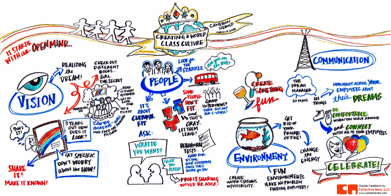I learned two new things from a Worldwide Story Work teleconference this week presented by Malcolm Jones, an expert in ideation and sketching. Well, probably a lot more than two, but these were the ones that really stood out.
- An affinity for visual storytelling over text-based storytelling (or
 vice versa) probably reflects one’s learning style. Yes, that’s kind of a “duh” statement, and I’m sure I knew it on some level, but I hadn’t thought about it before Jones’s teleconference (even though Wednesday’s entry was about learning styles). I found it difficult to personally relate to Jones’s assertion that writing is very difficult for many people; yet, that observation is true to my experience. Writing comes incredibly easily to me, but I know from six-plus years of teaching business communication to college students that writing is agony for many. Some find linear storytelling to be a painful process, Jones says, and visual storytelling is less linear and more spatial than written storytelling. He also points out that the brain takes in visual stories differently than it takes in linear, written stories, yielding different insights. And an affinity for one over the other reflects differences in right- or left-brain dominance. Especially intriguing was Jones’s reminder that some 60 percent of people are visual learners. Given that stat, it’s almost surprising that visual storytelling isn’t more dominant over text-based storytelling.
vice versa) probably reflects one’s learning style. Yes, that’s kind of a “duh” statement, and I’m sure I knew it on some level, but I hadn’t thought about it before Jones’s teleconference (even though Wednesday’s entry was about learning styles). I found it difficult to personally relate to Jones’s assertion that writing is very difficult for many people; yet, that observation is true to my experience. Writing comes incredibly easily to me, but I know from six-plus years of teaching business communication to college students that writing is agony for many. Some find linear storytelling to be a painful process, Jones says, and visual storytelling is less linear and more spatial than written storytelling. He also points out that the brain takes in visual stories differently than it takes in linear, written stories, yielding different insights. And an affinity for one over the other reflects differences in right- or left-brain dominance. Especially intriguing was Jones’s reminder that some 60 percent of people are visual learners. Given that stat, it’s almost surprising that visual storytelling isn’t more dominant over text-based storytelling. - Like other kinds of storytelling, visual storytelling is now being used in business — in business comics, games and other forms of play, and a field that was completely new to me, graphic facilitation. Jones cited Kevin Cheng as a major name in using comics for User Experience Design and later shared with me links by and about Cheng: The Power of Comics: An Interview with Kevin Cheng, Communicating Concepts Through Comics from Cheng’s own blog, and Examples of Comics in Designing Customer Experiences. In graphic facilitation, Jones says, a graphic artist works with a facilitator to create a visual story of what goes on in a group meeting. A site describing an upcoming workshop on Graphic Facilitation also provides a good description: “Using graphics to lead group process in a highly engaging, interactive way. … Participants learn to draw, create large-format displays, record, and practice facilitating and receiving feedback. They also design a meeting process and learn about methods of documenting visual meetings” and Graphic Facilitation is all about “applying visual language to group processes.” (A couple of resources on Graphic Facilitation: The Center for Graphic Facilitation,
 Graphic Facilitation Focuses A Group’s Thoughts — and apparently the definitive book on the discipline is David Sibbet’s Graphic Facilitation: Transforming Groups with the Power of Visual Listening).
Graphic Facilitation Focuses A Group’s Thoughts — and apparently the definitive book on the discipline is David Sibbet’s Graphic Facilitation: Transforming Groups with the Power of Visual Listening).
Jones also noted that storytelling literally comes into play in business in the form of games and role-plays. He reported that corporate groups are building things out of LEGOs to solve business problems, using a process called LEGO Serious Play. Jones cited a book on business play, which seems to cover more than just LEGOs, Serious Play.
in business in the form of games and role-plays. He reported that corporate groups are building things out of LEGOs to solve business problems, using a process called LEGO Serious Play. Jones cited a book on business play, which seems to cover more than just LEGOs, Serious Play.
 Jones talked a bit about comics and storyboarding and recommended three tools:
Jones talked a bit about comics and storyboarding and recommended three tools:
- WittyComics, one of Jones’s favorites
- StripCreator
- DesignComics (Jones wasn’t very enthusiastic about this one).
To that list, I would add ComicLife, the comic software app for Mac. I’ve never used ComicLife for an actual comic, but I use it lots of other graphics functions since I don’t have and don’t know how to use Photoshop. As Jones notes, these tools can help one tell a story with comics — but necessarily a good story.
